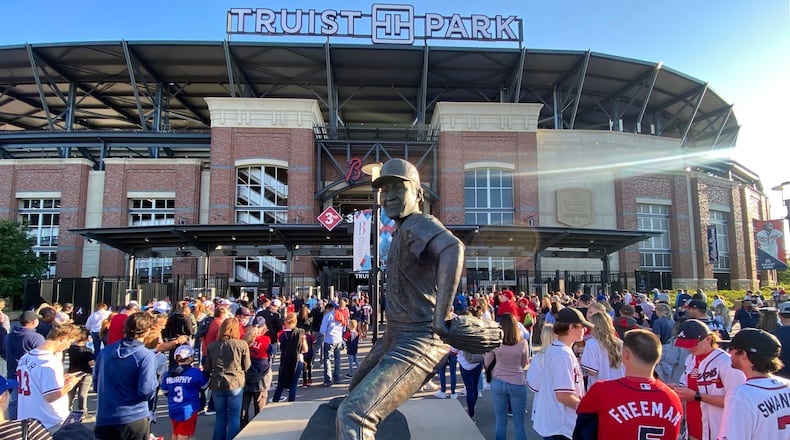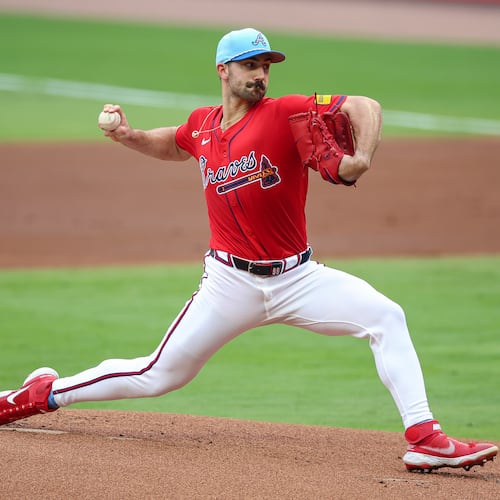About the only thing that has gone well for the Braves in this troubled season is that fans have begun to return to the ballpark in near pre-pandemic numbers.
After starting the season with reduced capacity at Truist Park, the Braves became the second MLB team to reopen to full crowds in May and, largely as a result of that early reopening, reached the All-Star break with baseball’s highest average attendance per home date of 27,774.
From June 1 until the All-Star break, the Braves averaged 32,714 fans per game, down about 5% from the same stretch in the 2019 season, when their attendance reached a 12-year high.
Team officials are encouraged by the recent numbers after a 2020 season played without fans in the stands and with looming questions about how readily they would return when the gates reopened.
“We are very excited about how the fans have come back,” Braves president and CEO Derek Schiller said. “Having people back in the ballpark is really a representative sign of how the community is coming back and opening up again.
“I think when we were in the depths of the pandemic, we really didn’t know what the impact was going to be long-term. There was even maybe a wonderment, by not having attended any games during the 2020 season, if somebody would say, ‘You know what, that’s not something I’m going to do any more.’ But I think we’ve seen quite the opposite.”
Credit: HYOSUB SHIN / AJC
Credit: HYOSUB SHIN / AJC
Truist Park’s attendance was limited to 33% and then 50% of full capacity in April before reopening to 100% starting with the first homestand in May. The only MLB team to reopen to full capacity earlier than the Braves was the Texas Rangers. All 29 U.S.-based teams are now back to full capacity in their home stadiums, while the Toronto Blue Jays continue to play home games in Buffalo, N.Y.
The Braves return from the All-Star break Friday to start a six-game homestand that includes a three-game series against the Tampa Bay Rays this weekend and a three-game series against the San Diego Padres early next week.
Schiller said the Braves’ advance ticket sales for the rest of the season are “trending very strongly.” But attendance could be tested after the team, which hasn’t had a winning record at any point this season, lost star outfielder Ronald Acuna to a season-ending knee injury in the next-to-last game before the All-Star break.
“He’s the most dynamic player in Major League Baseball in my opinion, so you can’t help but feel there is going to be a void in coming to a game and not being able to see him play again this year,” Schiller said. “But it’s a team sport, and we’re going to have other guys that step up hopefully and do great things. Hopefully, there will be some really magical moments that occur during the second half of this season.”
The Braves drew 2.65 million fans in 2019, an average of 32,779 per game, their highest attendance since 2007. They’ll fall short of the 2019 level this year, partially because of the reduced capacity in April, and are on pace to draw almost 2.25 million. They drew 2.51 million in 2017, their first season at SunTrust Park (now Truist Park), and 2.56 million in 2018. (MLB defines attendance as tickets sold.)
“I think we’re going to be down from what the total 2019 or 2018 or 2017 attendance was,” Schiller said. “But we obviously had a full month’s worth of games that were reduced capacity, and if you take that out and normalize it from that, I’d say we have as strong, if not stronger, attendance.”
He feels good about that, especially in light of all that has gone wrong so far this season. “I’ve been in pro sports 25 years-plus,” Schiller said, “and I can’t think of a single season where we’ve had this many things of all types and situations occur to us.”
The Braves’ disappointing record on the field – 44-45 — seems to have taken a larger toll on TV ratings than on attendance.
Braves telecasts on Bally Sports South and Bally Sports Southeast have averaged a 2.6 rating in the Atlanta TV market this season -- down 18% from a 3.18 rating at the midpoint of the 2019 season. (The pandemic-shortened 2020 season didn’t begin until late July.)
This season’s ratings remain 27% higher than in the first half of 2017, the last season before this one in which the Braves had a below-.500 record at the All-Star break. In 2017, when the Braves were 42-45 at the break, their telecasts averaged a 2.04 rating in the Atlanta market at that point.
About the Author
Keep Reading
The Latest
Featured




